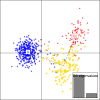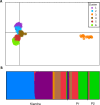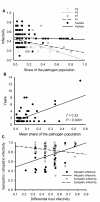Genetic analysis reveals long-standing population differentiation and high diversity in the rust pathogen Melampsora lini
- PMID: 32810177
- PMCID: PMC7454959
- DOI: 10.1371/journal.ppat.1008731
Genetic analysis reveals long-standing population differentiation and high diversity in the rust pathogen Melampsora lini
Abstract
A priority for research on infectious disease is to understand how epidemiological and evolutionary processes interact to influence pathogen population dynamics and disease outcomes. However, little is understood about how population adaptation changes across time, how sexual vs. asexual reproduction contribute to the spread of pathogens in wild populations and how diversity measured with neutral and selectively important markers correlates across years. Here, we report results from a long-term study of epidemiological and genetic dynamics within several natural populations of the Linum marginale-Melampsora lini plant-pathogen interaction. Using pathogen isolates collected from three populations of wild flax (L. marginale) spanning 16 annual epidemics, we probe links between pathogen population dynamics, phenotypic variation for infectivity and genomic polymorphism. Pathogen genotyping was performed using 1567 genome-wide SNP loci and sequence data from two infectivity loci (AvrP123, AvrP4). Pathogen isolates were phenotyped for infectivity using a differential set. Patterns of epidemic development were assessed by conducting surveys of infection prevalence in one population (Kiandra) annually. Bayesian clustering analyses revealed host population and ecotype as key predictors of pathogen genetic structure. Despite strong fluctuations in pathogen population size and severe annual bottlenecks, analysis of molecular variance revealed that pathogen population differentiation was relatively stable over time. Annually, varying levels of clonal spread (0-44.8%) contributed to epidemics. However, within populations, temporal genetic composition was dynamic with rapid turnover of pathogen genotypes, despite the dominance of only four infectivity phenotypes across the entire study period. Furthermore, in the presence of strong fluctuations in population size and migration, spatial selection may maintain pathogen populations that, despite being phenotypically stable, are genetically highly dynamic.
Conflict of interest statement
The authors have declared that no competing interests exist.
Figures





Similar articles
-
Diversity and evolution of effector loci in natural populations of the plant pathogen Melampsora lini.Mol Biol Evol. 2009 Nov;26(11):2499-513. doi: 10.1093/molbev/msp166. Epub 2009 Jul 24. Mol Biol Evol. 2009. PMID: 19633228 Free PMC article.
-
Population processes at multiple spatial scales maintain diversity and adaptation in the Linum marginale--Melampsora lini association.PLoS One. 2012;7(7):e41366. doi: 10.1371/journal.pone.0041366. Epub 2012 Jul 31. PLoS One. 2012. PMID: 22859978 Free PMC article.
-
Host ecotype generates evolutionary and epidemiological divergence across a pathogen metapopulation.Proc Biol Sci. 2014 Jul 22;281(1787):20140522. doi: 10.1098/rspb.2014.0522. Proc Biol Sci. 2014. PMID: 24870042 Free PMC article.
-
Co-evolutionary interactions between host resistance and pathogen effector genes in flax rust disease.Mol Plant Pathol. 2011 Jan;12(1):93-102. doi: 10.1111/j.1364-3703.2010.00657.x. Epub 2010 Aug 29. Mol Plant Pathol. 2011. PMID: 21118351 Free PMC article. Review.
-
Diversity of Puccinia striiformis on cereals and grasses.Annu Rev Phytopathol. 2011;49:197-217. doi: 10.1146/annurev-phyto-072910-095230. Annu Rev Phytopathol. 2011. PMID: 21599494 Review.
Cited by
-
Population-level deep sequencing reveals the interplay of clonal and sexual reproduction in the fungal wheat pathogen Zymoseptoria tritici.Microb Genom. 2021 Oct;7(10):000678. doi: 10.1099/mgen.0.000678. Microb Genom. 2021. PMID: 34617882 Free PMC article.
-
Recombination triggers fungal crop disease.Nat Ecol Evol. 2023 Dec;7(12):1961-1962. doi: 10.1038/s41559-023-02132-7. Nat Ecol Evol. 2023. PMID: 37945943 No abstract available.
-
A pathogen's spatial range is not constrained by geographical features in the flax rust pathosystem.Ecol Evol. 2023 Oct 9;13(10):e10577. doi: 10.1002/ece3.10577. eCollection 2023 Oct. Ecol Evol. 2023. PMID: 37818245 Free PMC article.
-
Genetic Analysis of Plant Pathogens Natural Populations.Methods Mol Biol. 2022;2536:405-422. doi: 10.1007/978-1-0716-2517-0_23. Methods Mol Biol. 2022. PMID: 35819617
-
Developing a crop- wild-reservoir pathogen system to understand pathogen evolution and emergence.Elife. 2025 Apr 11;14:e91245. doi: 10.7554/eLife.91245. Elife. 2025. PMID: 40215176 Free PMC article.
References
-
- McDonald BA and Linde C (2002) The population genetics of plant pathogens and breeding strategies for durable resistance. Euphytica 124: 163–180.
-
- Shaw MW (2006) Pathogen population dynamics. The Epidemiology of Plant Diseases. Springer; pp. 193–214.
Publication types
MeSH terms
LinkOut - more resources
Full Text Sources

